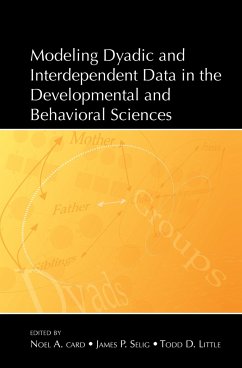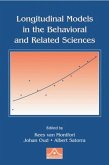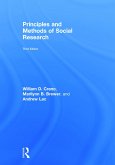Modeling Dyadic and Interdependent Data in the Developmental and Behavioral Sciences
Herausgeber: Card, Noel A; Little, Todd; Selig, James P
Modeling Dyadic and Interdependent Data in the Developmental and Behavioral Sciences
Herausgeber: Card, Noel A; Little, Todd; Selig, James P
- Gebundenes Buch
- Merkliste
- Auf die Merkliste
- Bewerten Bewerten
- Teilen
- Produkt teilen
- Produkterinnerung
- Produkterinnerung
First Published in 2008. Routledge is an imprint of Taylor & Francis, an informa company.
Andere Kunden interessierten sich auch für
![Data Analysis Data Analysis]() Charles M. JuddData Analysis198,99 €
Charles M. JuddData Analysis198,99 €![Longitudinal Data Analysis Longitudinal Data Analysis]() Longitudinal Data Analysis184,99 €
Longitudinal Data Analysis184,99 €![Longitudinal Models in the Behavioral and Related Sciences Longitudinal Models in the Behavioral and Related Sciences]() Longitudinal Models in the Behavioral and Related Sciences203,99 €
Longitudinal Models in the Behavioral and Related Sciences203,99 €![The Methodological Dilemma Revisited The Methodological Dilemma Revisited]() The Methodological Dilemma Revisited173,99 €
The Methodological Dilemma Revisited173,99 €![Statistical Power Analysis Statistical Power Analysis]() Brett MyorsStatistical Power Analysis163,99 €
Brett MyorsStatistical Power Analysis163,99 €![Principles and Methods of Social Research Principles and Methods of Social Research]() William D CranoPrinciples and Methods of Social Research211,99 €
William D CranoPrinciples and Methods of Social Research211,99 €![Embracing the Messy Complexities of Co-Creation Embracing the Messy Complexities of Co-Creation]() Louise PhillipsEmbracing the Messy Complexities of Co-Creation172,99 €
Louise PhillipsEmbracing the Messy Complexities of Co-Creation172,99 €-
-
-
First Published in 2008. Routledge is an imprint of Taylor & Francis, an informa company.
Produktdetails
- Produktdetails
- Verlag: Taylor & Francis Ltd (Sales)
- Seitenzahl: 460
- Erscheinungstermin: 1. Juni 2008
- Englisch
- Abmessung: 231mm x 150mm x 30mm
- Gewicht: 748g
- ISBN-13: 9780805859720
- ISBN-10: 0805859721
- Artikelnr.: 23582969
- Herstellerkennzeichnung
- Libri GmbH
- Europaallee 1
- 36244 Bad Hersfeld
- gpsr@libri.de
- Verlag: Taylor & Francis Ltd (Sales)
- Seitenzahl: 460
- Erscheinungstermin: 1. Juni 2008
- Englisch
- Abmessung: 231mm x 150mm x 30mm
- Gewicht: 748g
- ISBN-13: 9780805859720
- ISBN-10: 0805859721
- Artikelnr.: 23582969
- Herstellerkennzeichnung
- Libri GmbH
- Europaallee 1
- 36244 Bad Hersfeld
- gpsr@libri.de
Noel A. Card is Assistant Professor of Family Studies and Human Development at the University of Arizona. He received his PhD in Clinical Psychology from St. John's University. James P. Selig is a Doctoral Candidate in Quantitative Psychology at the University of Kansas. Todd D. Little is Director of the Research Design and Analysis Unit and Director of the Quantitative Psychology doctoral training program at the University of Kansas. He received his PhD in Developmental Psychology from the University of California at Riverside.
N.A. Card
T.D. Little
J.P. Selig
Modeling Dyadic and Interdependent Data in Developmental Research: An Introduction. B. Laursen
D. Popp
W.J. Burk
M. Kerr
H. Stattin
Incorporating Interdependence into Developmental Research: Examples from the Study of Homophily and Homogeneity. W.L. Cook
Application of the Social Relations Model Formulas to Developmental Research. A.H.N. Cillessen
C. Borch
Analyzing Social Networks in Adolescence. N. Ram
A.B. Pedersen
Dyadic Models Emerging from the Longitudinal Structural Equation Modeling Tradition: Parallels with Ecological Models of Interspecific Interactions. E. Ferrer
K.F. Widaman
Multilevel Structural Equation Models for Contextual Factors with Inter-Group Differences. P. Sadler
E. Woody
It Takes Two: A Dyadic
SEM-Based Perspective on Personality Development. D.A. Kashy
M.B. Donnellan
Comparing MLM and SEM Approaches to Analyzing Developmental Dyadic Data: Growth Curve Models of Hostility in Families. J.P. Selig
K.A. McNamara
N.A. Card
T.D. Little
Techniques for Modeling Dependency in Interchangeable Dyads. T.E. Malloy
A.H.N. Cillessen
Variance Component Analysis of Generalized and Dyadic Peer Perceptions in Adolescence. N.A. Card
T.D. Little
J.P. Selig
Using the Bivariate Social Relations Model to Study Dyadic Relationships: Early Adolescents' Perceptions of Friends' Aggression and Prosocial Behavior. S.J.T. Branje
C. Finkenauer
W.H.J. Meeus
Modeling Interdependence Using the Social Relations Model: The Investment Model in Family Relationships. J. Templin
Methods for Detecting Subgroups in Social Networks. T.A. Kindermann
Can We Use Causal Inferences about the Influence of Children's Naturally-Existing Social Networks on their School Motivation? B.J.H. Zijlstra
R. Veenstra
M.A.J. Van Duijn
An Application of the Multilevel Model for Binary Network Data on Bully-Victim Relationships. C.F. Bond
Jr.
D. Cross
Beyond the Dyad: Prospects for Social Development. D.A. Kenny
Thinking about the Developmental Course of Relationships.
T.D. Little
J.P. Selig
Modeling Dyadic and Interdependent Data in Developmental Research: An Introduction. B. Laursen
D. Popp
W.J. Burk
M. Kerr
H. Stattin
Incorporating Interdependence into Developmental Research: Examples from the Study of Homophily and Homogeneity. W.L. Cook
Application of the Social Relations Model Formulas to Developmental Research. A.H.N. Cillessen
C. Borch
Analyzing Social Networks in Adolescence. N. Ram
A.B. Pedersen
Dyadic Models Emerging from the Longitudinal Structural Equation Modeling Tradition: Parallels with Ecological Models of Interspecific Interactions. E. Ferrer
K.F. Widaman
Multilevel Structural Equation Models for Contextual Factors with Inter-Group Differences. P. Sadler
E. Woody
It Takes Two: A Dyadic
SEM-Based Perspective on Personality Development. D.A. Kashy
M.B. Donnellan
Comparing MLM and SEM Approaches to Analyzing Developmental Dyadic Data: Growth Curve Models of Hostility in Families. J.P. Selig
K.A. McNamara
N.A. Card
T.D. Little
Techniques for Modeling Dependency in Interchangeable Dyads. T.E. Malloy
A.H.N. Cillessen
Variance Component Analysis of Generalized and Dyadic Peer Perceptions in Adolescence. N.A. Card
T.D. Little
J.P. Selig
Using the Bivariate Social Relations Model to Study Dyadic Relationships: Early Adolescents' Perceptions of Friends' Aggression and Prosocial Behavior. S.J.T. Branje
C. Finkenauer
W.H.J. Meeus
Modeling Interdependence Using the Social Relations Model: The Investment Model in Family Relationships. J. Templin
Methods for Detecting Subgroups in Social Networks. T.A. Kindermann
Can We Use Causal Inferences about the Influence of Children's Naturally-Existing Social Networks on their School Motivation? B.J.H. Zijlstra
R. Veenstra
M.A.J. Van Duijn
An Application of the Multilevel Model for Binary Network Data on Bully-Victim Relationships. C.F. Bond
Jr.
D. Cross
Beyond the Dyad: Prospects for Social Development. D.A. Kenny
Thinking about the Developmental Course of Relationships.
N.A. Card
T.D. Little
J.P. Selig
Modeling Dyadic and Interdependent Data in Developmental Research: An Introduction. B. Laursen
D. Popp
W.J. Burk
M. Kerr
H. Stattin
Incorporating Interdependence into Developmental Research: Examples from the Study of Homophily and Homogeneity. W.L. Cook
Application of the Social Relations Model Formulas to Developmental Research. A.H.N. Cillessen
C. Borch
Analyzing Social Networks in Adolescence. N. Ram
A.B. Pedersen
Dyadic Models Emerging from the Longitudinal Structural Equation Modeling Tradition: Parallels with Ecological Models of Interspecific Interactions. E. Ferrer
K.F. Widaman
Multilevel Structural Equation Models for Contextual Factors with Inter-Group Differences. P. Sadler
E. Woody
It Takes Two: A Dyadic
SEM-Based Perspective on Personality Development. D.A. Kashy
M.B. Donnellan
Comparing MLM and SEM Approaches to Analyzing Developmental Dyadic Data: Growth Curve Models of Hostility in Families. J.P. Selig
K.A. McNamara
N.A. Card
T.D. Little
Techniques for Modeling Dependency in Interchangeable Dyads. T.E. Malloy
A.H.N. Cillessen
Variance Component Analysis of Generalized and Dyadic Peer Perceptions in Adolescence. N.A. Card
T.D. Little
J.P. Selig
Using the Bivariate Social Relations Model to Study Dyadic Relationships: Early Adolescents' Perceptions of Friends' Aggression and Prosocial Behavior. S.J.T. Branje
C. Finkenauer
W.H.J. Meeus
Modeling Interdependence Using the Social Relations Model: The Investment Model in Family Relationships. J. Templin
Methods for Detecting Subgroups in Social Networks. T.A. Kindermann
Can We Use Causal Inferences about the Influence of Children's Naturally-Existing Social Networks on their School Motivation? B.J.H. Zijlstra
R. Veenstra
M.A.J. Van Duijn
An Application of the Multilevel Model for Binary Network Data on Bully-Victim Relationships. C.F. Bond
Jr.
D. Cross
Beyond the Dyad: Prospects for Social Development. D.A. Kenny
Thinking about the Developmental Course of Relationships.
T.D. Little
J.P. Selig
Modeling Dyadic and Interdependent Data in Developmental Research: An Introduction. B. Laursen
D. Popp
W.J. Burk
M. Kerr
H. Stattin
Incorporating Interdependence into Developmental Research: Examples from the Study of Homophily and Homogeneity. W.L. Cook
Application of the Social Relations Model Formulas to Developmental Research. A.H.N. Cillessen
C. Borch
Analyzing Social Networks in Adolescence. N. Ram
A.B. Pedersen
Dyadic Models Emerging from the Longitudinal Structural Equation Modeling Tradition: Parallels with Ecological Models of Interspecific Interactions. E. Ferrer
K.F. Widaman
Multilevel Structural Equation Models for Contextual Factors with Inter-Group Differences. P. Sadler
E. Woody
It Takes Two: A Dyadic
SEM-Based Perspective on Personality Development. D.A. Kashy
M.B. Donnellan
Comparing MLM and SEM Approaches to Analyzing Developmental Dyadic Data: Growth Curve Models of Hostility in Families. J.P. Selig
K.A. McNamara
N.A. Card
T.D. Little
Techniques for Modeling Dependency in Interchangeable Dyads. T.E. Malloy
A.H.N. Cillessen
Variance Component Analysis of Generalized and Dyadic Peer Perceptions in Adolescence. N.A. Card
T.D. Little
J.P. Selig
Using the Bivariate Social Relations Model to Study Dyadic Relationships: Early Adolescents' Perceptions of Friends' Aggression and Prosocial Behavior. S.J.T. Branje
C. Finkenauer
W.H.J. Meeus
Modeling Interdependence Using the Social Relations Model: The Investment Model in Family Relationships. J. Templin
Methods for Detecting Subgroups in Social Networks. T.A. Kindermann
Can We Use Causal Inferences about the Influence of Children's Naturally-Existing Social Networks on their School Motivation? B.J.H. Zijlstra
R. Veenstra
M.A.J. Van Duijn
An Application of the Multilevel Model for Binary Network Data on Bully-Victim Relationships. C.F. Bond
Jr.
D. Cross
Beyond the Dyad: Prospects for Social Development. D.A. Kenny
Thinking about the Developmental Course of Relationships.









